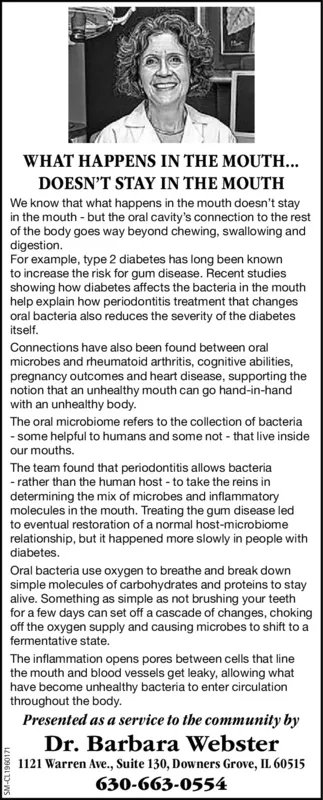Advertisement

-
Published Date
March 3, 2022This ad was originally published on this date and may contain an offer that is no longer valid. To learn more about this business and its most recent offers, click here.
Ad Text
WHAT HAPPENS IN THE MOUTH... DOESN'T STAY IN THE MOUTH We know that what happens in the mouth doesn't stay in the mouth - but the oral cavity's connection to the rest of the body goes way beyond chewing, swallowing and digestion. For example, type 2 diabetes has long been known to increase the risk for gum disease. Recent studies showing how diabetes affects the bacteria in the mouth help explain how periodontitis treatment that changes oral bacteria also reduces the severity of the diabetes itself. Connections have also been found between oral microbes and rheumatoid arthritis, cognitive abilities, pregnancy outcomes and heart disease, supporting the notion that an unhealthy mouth can go hand-in-hand with an unhealthy body. The oral microbiome refers to the collection of bacteria - some helpful to humans and some not - that live inside our mouths. The team found that periodontitis allows bacteria - rather than the human host - to take the reins in determining the mix of microbes and inflammatory molecules in the mouth. Treating the gum disease led to eventual restoration of a normal host-microbiome relationship, but it happened more slowly in people with diabetes. Oral bacteria use oxygen to breathe and break down simple molecules of carbohydrates and proteins to stay alive. Something as simple as not brushing your teeth for a few days can set off a cascade of changes, choking off the oxygen supply and causing microbes to shift to a fermentative state. The inflammation opens pores between cells that line the mouth and blood vessels get leaky, allowing what have become unhealthy bacteria to enter circulation throughout the body. Presented as a service to the community by Dr. Barbara Webster 1121 Warren Ave., Suite 130, Downers Grove, IL 60515 630-663-0554 SM-CL1960171 WHAT HAPPENS IN THE MOUTH... DOESN'T STAY IN THE MOUTH We know that what happens in the mouth doesn't stay in the mouth - but the oral cavity's connection to the rest of the body goes way beyond chewing, swallowing and digestion. For example, type 2 diabetes has long been known to increase the risk for gum disease. Recent studies showing how diabetes affects the bacteria in the mouth help explain how periodontitis treatment that changes oral bacteria also reduces the severity of the diabetes itself. Connections have also been found between oral microbes and rheumatoid arthritis, cognitive abilities, pregnancy outcomes and heart disease, supporting the notion that an unhealthy mouth can go hand-in-hand with an unhealthy body. The oral microbiome refers to the collection of bacteria - some helpful to humans and some not - that live inside our mouths. The team found that periodontitis allows bacteria - rather than the human host - to take the reins in determining the mix of microbes and inflammatory molecules in the mouth. Treating the gum disease led to eventual restoration of a normal host-microbiome relationship, but it happened more slowly in people with diabetes. Oral bacteria use oxygen to breathe and break down simple molecules of carbohydrates and proteins to stay alive. Something as simple as not brushing your teeth for a few days can set off a cascade of changes, choking off the oxygen supply and causing microbes to shift to a fermentative state. The inflammation opens pores between cells that line the mouth and blood vessels get leaky, allowing what have become unhealthy bacteria to enter circulation throughout the body. Presented as a service to the community by Dr. Barbara Webster 1121 Warren Ave., Suite 130, Downers Grove, IL 60515 630-663-0554 SM-CL1960171
